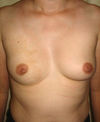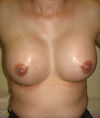The Procedure
Many patients are born with inverted nipples. These may get worse with advancing age. Inverted nipples may cause cosmetic concerns, and can interfere with breast feeding.
The sudden appearance of inverted nipples can be a sign of possible breast cancer. You should consult your doctor if this applies to you.
There are three degrees of severity :
- Grade 1 – These nipples are occasionally inverted, but will evert spontaneously. Surgery is not required for this group.
- Grade 2 - Nipples in this category will not evert spontaneously, but can be manually pulled out. Surgery can benefit patients in this category.
- Grade 3 - This is the most severely affected group. The nipples cannot manually be pulled out. Surgery is the only method for correction in this group.
There are many operations described for inverted nipples. One of the most conservative and effective operations is the use of nipple piercing. This method is Dr. Belt’s first choice for most patients.
This can be performed under local or general anaesthetic. A “barbell” device is passed from 3 to 9 o’ clock. This stretches the contracted nipple ducts. The piercing has to be left in continuously for 6 months. Once removed the ducts remain in their stretched state, so correcting the inverted nipples.
Mild degrees of inverted nipples can also be corrected with breast augmentation. The correction is produced by the implant pushing the breast tissue forward, effectively increasing the length of the tethered and shortened ducts.
Other techniques rely on cutting the ducts and are therefore more likely to impair breast feeding. These techniques are seldom used by Dr Belt and usually only after the piercing technique has failed.
As the piercing technique is the least destructive to the ducts, it is also less likely to result in permanent or excessive scarring. There is also a lower incidence of sensory loss.
Furthermore this technique is less likely to permanently damage or divide the milk ducts. It is therefore the technique that is least likely to interfere with breast feeding. It should be noted that even with surgery, some patients may not be able to breast feed successfully. This is especially so if they have the more severe grades of inverted nipple, and this may be the case with or without surgery.

Complications and Risks
All Procedures have potential complications and risks. These can be divided into general complications and those specific to each procedure. The latter are listed in the FAQs below.
General complications include:
- Wound complications - bleeding, bruising, collections under the skin of blood (haematoma), pus (abscess), serous fluid (seroma), infection, wound breakdown, suture extrusion, sensory loss;
- Aesthetic complications - poor scars, stretched scars, raised scars (keloid or hypertrophic), contour irregularities, need for revisional procedure;
- Anaesthetic complications














